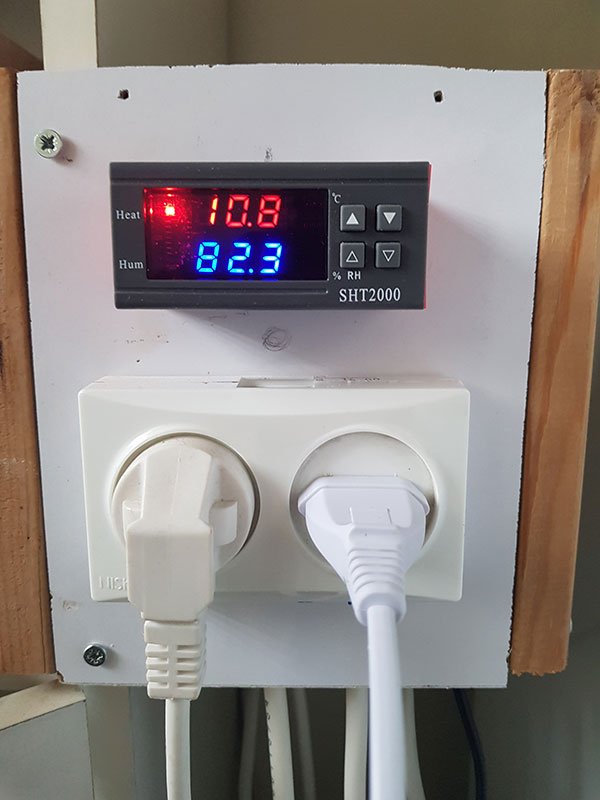
Yoel Blumberger
How to create and maintain the right humidity for your cheese while it’s aging… This is a very important subject for cheesemakers and we have tried to give you as much information as we can about it:
We have a large Tips & Techniques section on our website about how to make a cave and how to control the humidity using plastic boxes (click here).
We have also posted several articles through the years, including:
2016 – How to Add Humidity to Your Room-Sized “Cave”
2014 – Controlling Humidity in Your Cheese “Cave”
2010 – Using Hygrometers to Measure Humidity
New information is always welcome and we were thrilled recently to receive Yoel Blumberger’s ideas. (You may remember Yoel from his interview in June – Yoel Blumberger in Tel Aviv, Israel.)
A Humidity Control System
By Yoel Blumberger
My article is about controlling the cheese refrigerator, but these days, in light of the worldwide crisis, caused by the deadly virus, I want to share a thought about control in a broader sense.
People tend to think that they have some degree of control over their lives, at least for their immediate surroundings. However, a very distant tiny (0.1-micron) virus has brought humankind to its knees. It shows us that the level of control we have ascribed to ourselves is merely an illusion – control of governments, healthcare systems and other institutions, and individuals’ control of their own lives.
This does not mean that we have to let go and it does not mean that we have to give up. But yes, we have to become more modest, to adopt a more reasonable life style, to recognize our limitations and to try to become a little better in every sense. I think that making cheese or any other food product at home would make a small contribution to such an improvement.
Controlling Humidity
Humidity is one of the most important factors in making quality cheeses. There are different ways to handle this issue in your “cave.”
The humidity control system I have built controls humidity in my “cave” (a standard refrigerator) accurately and lets me change the humidity level very simply according to the aging cheeses, which are inside. I use a controller that controls also the temperature so it provides a complete solution for controlling the “cave” but you can install only the humidity part if you already have a good way to control the temperature. (Refrigerator Thermostat)
The system is based on two main components: controller and humidifier.
1. Controller
I use a digital controller that controls both temperature and humidity so both fridge and humidifier are connected to it. It uses one sensor probe to measure both temperature and humidity so I have only one probe cord going into the fridge, which is an advantage. There are two types of controllers regarding the power sockets. One with built-in sockets and the other one that comes without sockets. I installed the second type (Pic 1) as the sockets, which are in use in my country, differ from those offered on Amazon. One socket provides power to the humidifier and the second socket is for the fridge.

Pic 1 –The temperature in red and the humidity in blue. The red lamp left to the temperature means that there is current in the socket and the fridge is on now. The humidity is in between the min and max so the blue lamp is off, which means that the humidifier is off.
It is better to use the controller with the built in sockets (Pic 2). It is a simple and elegant solution and saves you work. Of course, you have to double check before you buy the controller that it supports the functions that are described later on and contains the probes. The price of this one in Amazon is 70$ and shipping is free. It also has an alarm function, which mine is lacking. If your budget is restricted, you can buy a dual controller (temp and humidity) without sockets for 27$ (like in Pic 1) and connect them by yourself or buy humidity controller with built in socket for 40$.

Pic 2 – controller with built in sockets.
My controller works very simply. I define the minimum level of the humidity and the maximum level. When the humidity drops below the minimum, the controller’s relay closes and there is power in the socket, which the humidifier is connected to. The humidifier starts to produce mist. The humidity increases and when it reaches the defined maximum humidity, the controller stops providing power. As a result, the humidifier stops working, so it stops emitting humidity.
It is the same with the temperature. When it reaches the minimum temperature, the fridge is disconnected and starts again after reaching the maximum temperature.
Again, you can buy a controller only for humidity. Check the length of the probe cord because this is what will dictate where the controller will be located by distance from the fridge. The maximum distance is the length of the cable minus, let’s say, 10 inches (the probe should be a little bit deep in the fridge – not too close to the door.
As I put the probe into the fridge and connected the controller to the power, without even connecting anything to it, I immediately enjoyed getting clear information on the temperature and humidity inside the fridge without even opening its door, as I had to do before, when using a small monitor inside the fridge.
2. Cold mist humidifier
This humidifier has some parameters that you need to consider, but the most important one is that it must have a mechanical on/off switch and not an electronic one. When it is open and you disconnect the power in the socket, it must start working again when the power in the socket is reconnected. The humidifiers that have an electronic touch button for power on/off will not start to work after disconnection without being manually started.
The humidifier I use holds half a gallon of water, and I have to refill it with water once in two weeks. This depends on the humidity level needed and the fridge size, but I assume it will be close to this in any case. Pic 3 shows a humidifier sold by Amazon (for 37$) which holds one gallon of water. You have to check the dimensions of the humidifier to see if you have enough space for it inside the fridge.

Pic 3 – Cold mist humidifier with on/off knob and variable output.
There are two ways to use the humidifier. I tried both:
a. Inside the fridge – this is simple and preferred. You fill the water and put the humidifier in the fridge and that is all. It will consume a space that could be used for cheese and you will need to take it out to refill, depending on how water is refilled (top, bottom, space in the fridge, etc.). If your space is limited, choose a smaller humidifier, or try the second option.
b. Outside the fridge. This one is a little bit complicated and not recommended. Put the humidifier on top of the fridge and connect one end of a tube to it’s nozzle (lid) in a way that there is no mist leakage. Insert the other end inside the fridge using tape to connect it to the sidewall, not too close to the humidity probe. The tube is supposed to drive the mist from the humidifier into the fridge. The advantages are clear but the problem is that at some given sets of parameter combinations (outside temperature, length and diameter of the tube and more), the mist is not enough or there is a mist condensation so you get water in the tube instead of humidity inside the fridge. If you use a tube with a relatively big diameter, it causes problems with closing the door.
Pic 4 shows the humidifier inside my “cave.” On the white tray are two experimental cheeses: one covered with wheat flakes that were soaked in whisky and one partially wrapped with algae.

Pic 4
Several general issues:
1. If the humidifier can regulate the output (like the one in the picture), operate it with near the minimum output so when arriving to the maximum defined, the system will not cross it and the cycle will be moderate. In my system, which is configured to 80-85% humidity, arriving from the minimum to the maximum is relatively fast and going back from the maximum to the minimum is slower.
2. As we use the humidifier near food, I advise you to buy one that has antibacterial and filtering capabilities and to use boiled water.
3. Don’t be tempted to buy an expensive and sophisticated humidifier that has a built-in controller instead of the control system. It is limited to a maximum of 85% humidity and when reaching this level, the humidity will keep going up to 90%, a level that the humidifier cannot stand as it ruins its computerized core.
4. One of the issues that arises in connection with the original use of the humidifier (which is to increase humidity in living rooms and even for babies) is the danger of the Legionella. This bacterium develops in stagnant water and causes Legionnaires’ disease. Infection is caused by inhaling infected water vapor. The use we make of the humidifier is completely safe for the reason that the Legionella bacterium does not exist in water with a temperature lower than 25C (77F), so the temperature of our refrigerator, which is around 12C (54F), has no conditions for its development.
5. When the humidity is controlled, you don’t have to use any more water bowls or to put the cheese inside containers of any kind.
6. Some of the humidifiers have changing color led lights. Do not let this disturb you. It will have a good effect on your cheeses!
Speaking about lights, there is also music… My Swiss friend Michael, the founder and owner of Mauerhofer cheeses was involved in a recent study conducted to determine whether music has an impact on the taste of cheese. As a dessert, you can read the interesting story of Mauerhofer which also includes a link to the research document here: https://cuisinehelvetica.com/2019/07/01/fromage-mauerhofer/
Good luck and have fun!














































































































































